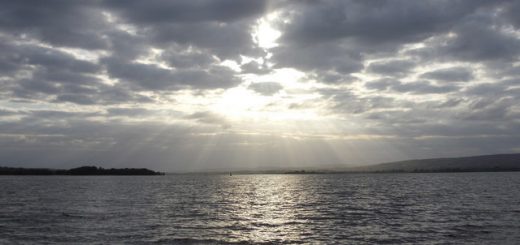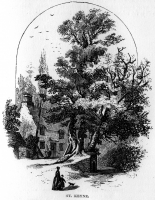Ynys Seiriol (a.k.a. Puffin Island, Ynys Glannauc, Priestholm and Ynys Lannog)
This island lying off Penmon Point (Trwyn Du) of Anglesey (Ynys Môn) was once known as Priestholm by the Vikings and Ynys Lannog by the Welsh. A charter from 1238AD refers to the canons of the Isle of Glannauch, another name for the island. Its modern Welsh name of Ynys Seiriol, is a reference to Saint Seiriol (born circa 494AD), a 6th Century Saint, (the son of King Owain Danwyn (Owen White teeth) of Rhos), who established a monastic settlement on the island. The now common English name of Puffin Island first occurred in the 18th Century, because it once had a large population of puffins and other sea birds, but since the brown rat (Rattus norvegicus) found its way to the island in the 1890’s the nesting sea bird population has plummeted.
![Matpib [GFDL (http://www.gnu.org/copyleft/fdl.html), CC-BY-SA-3.0 (http://creativecommons.org/licenses/by-sa/3.0/) or CC BY-SA 2.5 (https://creativecommons.org/licenses/by-sa/2.5)], from Wikimedia Commons](http://www.mysteriousbritain.co.uk/wp/wp-content/uploads/2008/09/800px-Puffin_Island-300x195.jpg) Saint Seiriol initially formed his cell on Penmon Point in the 6th Century, on the site of Penmon Priory, before moving to Ynys Seiriol later in life. It is thought that Saint Seiriol received the island from Einion Frenin, one of his older brothers, who also established the religious community on Bardsey Island (Ynys Enlli). Popular belief states that Saint Seiriol is buried on Ynys Seiriol, along with his cousin and patron, King Maelgwn Gwynedd (Maelgwn ap Cadwallon died 547AD), who ruled North Wales at the time when Saint Seiriol was setting up his religious communities. There is no evidence to either confirm or deny this belief.
Saint Seiriol initially formed his cell on Penmon Point in the 6th Century, on the site of Penmon Priory, before moving to Ynys Seiriol later in life. It is thought that Saint Seiriol received the island from Einion Frenin, one of his older brothers, who also established the religious community on Bardsey Island (Ynys Enlli). Popular belief states that Saint Seiriol is buried on Ynys Seiriol, along with his cousin and patron, King Maelgwn Gwynedd (Maelgwn ap Cadwallon died 547AD), who ruled North Wales at the time when Saint Seiriol was setting up his religious communities. There is no evidence to either confirm or deny this belief.
The Annales Cambriae (The Annals of Wales) say that King Cadwallon ap Cadfan (died 634AD), was besieged at Ynys Glannauc (Priestholm) whilst fleeing from a Anglo-Saxon invasion from Northumbria, and dates this to 629AD.
Giraldus Cambrensis wrote of the ecclesiastical settlement on the island in 1188AD during his travels around Wales. He said the settlement “inhabited by hermits, living by manual labour and serving God”. He also wrote that “according to legend, whenever there was strife within the community a plague of small mice would devour all their food”.
The island is uninhabited by humans these days, but there are the ruins of medieval monastic buildings, including the tower of a 12th Century church with a rare Norman style pyramid shaped roof. In 1748, the Welsh Hydrographer and poet Lewis Morris (2nd March 1701 – 11th April 1765) made a survey of the Welsh coast and made the recommendation that the tower of the ruined church on Ynys Seiriol be converted into a lighthouse. This was not implemented, and on the 17th August 1831, a wooden hulled paddle steamer on a day trip from Liverpool called ‘The Rothesay Castle’, ran aground on the Dutchman Bank in very heavy seas. Only 23 survivors were rescued from the 150 onboard. Unfortunately, the captain was said to have been drunk, and there was only one life boat that had a hole in it. Following this man-made disaster, a life boat was appointed at Penmon the following year, and the Penmon lighthouse was constructed in 1837. There is one identified shipwreck at Ynys Seiriol; ‘The Pioneer’ was a steamship that ran ashore in 1878 carrying a cargo of iron bars. It was being rescued after encountering engine failure near The Skerries, and so was adrift. Unfortunately the two tow lines that were attached to the ship broke.




Recent Comments